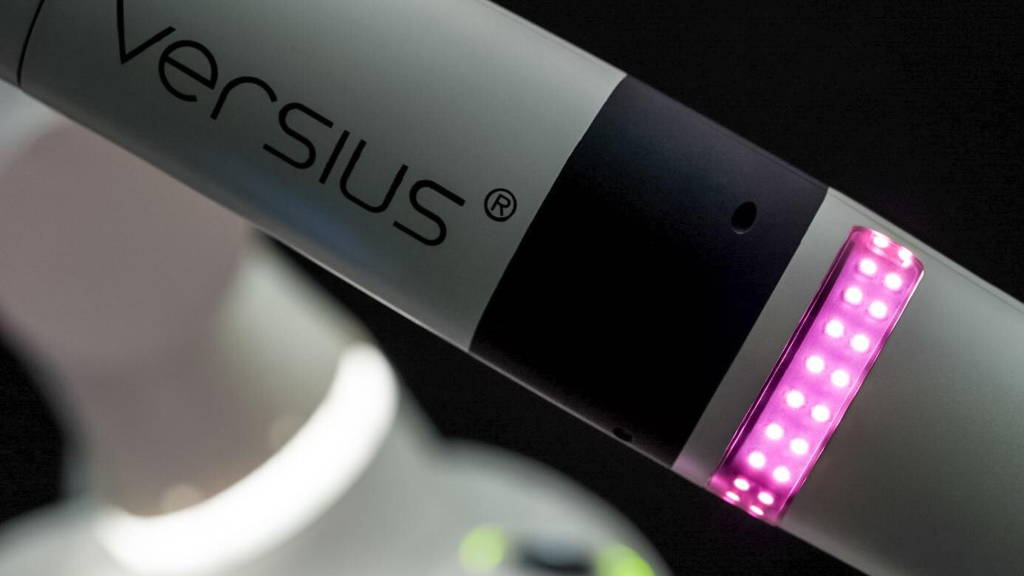The robot is called Versius. it mimics the human arm and can be used to carry out a wide range of laparoscopic procedures The Guardian writes. This includes hernia repairs, colorectal operations, and prostate and ear, nose and throat surgery. A series of small incisions are made to circumvent the need for traditional open surgery. This reduces complications and pain after surgery and speeds up recovery times for patients.
CMR says it’s already working with a number of NHS and private hospitals to introduce the robots. The current global market for surgical robots is worth approximately $4bn a year but this is expected to grow to $20bn by 2024.
Current day robots range from simple laboratory robots to highly complex surgical robots that can either aid a human surgeon or execute operations by themselves. In addition to surgery, they’re used in hospitals and labs for repetitive tasks, in rehabilitation, physical therapy and in support of those with long-term conditions.
CMR claims that surgical robot Versius will be much easier to use, takes up about a third of the space of current machines and will be no more expensive than non-robotic keyhole surgery. Versius is controlled by a surgeon at a console guided by a 3D screen in the operating theatre.
For robots to revolutionise surgery, Frost believes they need to be versatile, easy to use and small so that surgical staff can move them around the operating room or between operating theatres, or pack them away when they are not being used. “Our robot does all of this and is the first robotic arm to be designed specifically for laparoscopic surgery,” Frost said.
Whereas traditional industrial robotic arms are large and the wrists have three joints, Versius is the same size as a human arm and has four wrist joints, giving the surgeon “an unprecedented level of freedom to operate on the patient from whatever angle they want, versatility and reach,” Hares said.
The robot will be launched next spring and, once surgeons are trained, it should be available for procedures on patients by the end of next year.
CMR says it’s already working with a number of NHS and private hospitals to introduce the robots. The current global market for surgical robots is worth approximately $4bn a year but this is expected to grow to $20bn by 2024.
Robotic systems already widely used
Robots have been used in medicine for more than 30 years, consultancy firm PwC recently wrote in a publication on the proliferation of robotics and AI in healthcare. From the first programmable universal machine for assembly (PUMA), used in urology surgery in the 1980s, to the da Vinci robot, the most widely used robotic system in clinical use today, robots have been developed to perform a wide range of tasks and functions.Current day robots range from simple laboratory robots to highly complex surgical robots that can either aid a human surgeon or execute operations by themselves. In addition to surgery, they’re used in hospitals and labs for repetitive tasks, in rehabilitation, physical therapy and in support of those with long-term conditions.
CMR claims that surgical robot Versius will be much easier to use, takes up about a third of the space of current machines and will be no more expensive than non-robotic keyhole surgery. Versius is controlled by a surgeon at a console guided by a 3D screen in the operating theatre.
Robots: big, bulky and expensive
“Having robots in the operating theatre is not a new idea,” the Guardian quotes the company’s chief executive, Martin Frost. “The problem at the moment is that they are phenomenally expensive – not only do they cost £2m each to buy but every procedure costs an extra £3,000 using the robot – and they are very large. Many hospitals have to use the operating theatre around the robot. Their size can also make them difficult for the surgical team to use.”For robots to revolutionise surgery, Frost believes they need to be versatile, easy to use and small so that surgical staff can move them around the operating room or between operating theatres, or pack them away when they are not being used. “Our robot does all of this and is the first robotic arm to be designed specifically for laparoscopic surgery,” Frost said.
Versius wirks like human arm
One of the key benefits of the robot is that it works like a human arm and contains technology that detects resistance to make sure the right amount of force is used when the instruments are inside the patient. Luke Hares, chief technology officer at CMR says: “We took our inspiration from the human arm, the greatest surgical tool in history.”Whereas traditional industrial robotic arms are large and the wrists have three joints, Versius is the same size as a human arm and has four wrist joints, giving the surgeon “an unprecedented level of freedom to operate on the patient from whatever angle they want, versatility and reach,” Hares said.
The robot will be launched next spring and, once surgeons are trained, it should be available for procedures on patients by the end of next year.








